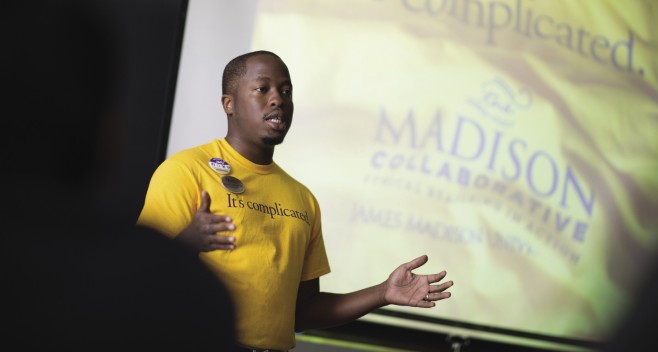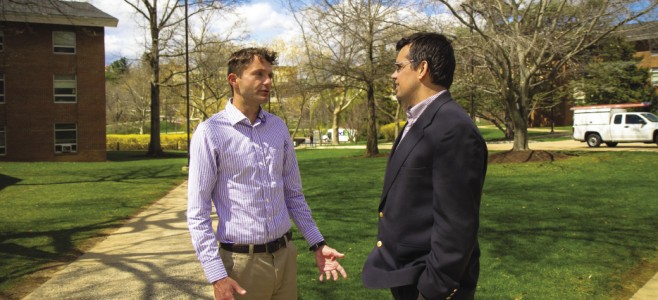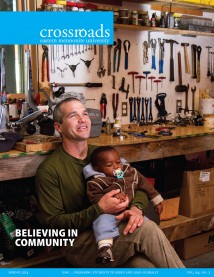
JMU staffer Alton Mosley Jr. led the “ethical reasoning in action” session at the 2013 orientation of incoming JMU students. (Photos by Mike Miriello, JMU Marketing Photography Department)
Not long after he’d come out of the closet, Mark was at a party with his friends. At some point that evening, a group of guys approached Mark and told him they suspected their roommate, Joe, was also gay. They asked if Mark would be willing to talk with Joe about this. 1
Mark thought it was an odd request, but he went upstairs and found Joe in his room. “Your roommates are questioning your sexuality, and asked me to talk with you,” Mark said. “If you want to talk, that’s fine, but I thought you should know what they’re saying.” Joe didn’t want to talk about it, and the two rejoined the party downstairs. (All along, this had simply been a cruel prank by Joe’s roommates, intended to put him and Mark into an awkward situation.)
By the time Mark got up to leave, Joe had gotten quite drunk. He followed Mark outside, and as Mark walked down the steps, Joe yelled “faggot” and punched him in the face. Mark picked himself up and hurried home.
A year went by, during which Mark avoided Joe and his friends. He lived in fear, and wondered if this is what the rest of his life as a gay man would be like. Just before graduation, Mark heard Josh Bacon, director of James Madison University’s Office of Judicial Affairs, speak in one of his classes about something called “restorative justice.” It sounded like something that might be useful in addressing what happened outside the party that night, and Mark approached Bacon after class to ask about it. (Mark was specifically interested in a restorative justice approach; he declined to pursue the matter through the legal system or JMU’s traditional judicial affairs process.)
Bacon thought the incident would be an ideal one to address through a restorative process and agreed to help set up a meeting. For his part, Joe had also been troubled by the punch he threw that night, and immediately guessed what was on Bacon’s mind when he called from judicial affairs. Joe agreed to meet and talk with Mark.
In experimental stage
Having taken graduate-level courses in restorative justice at EMU, Bacon was in the experimental stage of using restorative processes to address a student conflict at JMU. He pulled out all the stops. He rearranged his office furniture into a circle, and used a medal commemorating JMU’s centennial as a “talking piece” that was passed from person to person. 2
Mark and Joe sat in that circle for an hour and a half. Mark told Joe about the fear he’d lived with since that night. Joe apologized, and told Mark how his sexuality had been repeatedly questioned before Mark approached him at the party, and how, in the drunken, late-night logic of the moment, he’d decided to respond in the manliest way he could think of: with his fists. Things didn’t end with complete reconciliation and fast friendship between the two, but Mark and Joe reached a point of empathy for one another. It was a dynamic that Bacon had very rarely seen with discipline cases he had handled through the traditional judicial affairs process. Afterwards, both Mark and Joe independently contacted Bacon to thank him for what he’d done – a telling indicator of how powerful the process had been for both of them.
“I can count on one hand how many thank-you cards I’ve gotten in judicial affairs,” says Bacon, who is now associate dean of students. “This sold me on restorative justice.”
Today, looking back on this early use of restorative justice in his office, Bacon emphasizes how radically different things could have been had the incident been handled by the traditional student discipline book. Joe’s violent actions could have been prosecuted as a hate crime, involving multiple hearings during which the lawyers’ clocks would have been spinning at some frightful hourly rate. Even more importantly, Mark and Joe would not have had the opportunity to speak directly and honestly to one another, meaning neither would have had the “chance for healing, for apologies, for understanding,” says Bacon.
“Blown away” by Zehr’s class
During most of the 15 years he’s spent so far in judicial affairs at JMU, Bacon came across the term “restorative justice” from time to time. Like many in his field, he’d generally held a vague and incorrect notion that it mainly involved restitution after some sort of wrongdoing. At some point, he became aware that Howard Zehr, often called the “grandfather of restorative justice,” just so happened to work practically next door at Eastern Mennonite University, and he decided to check out the whole restorative justice thing in a little more detail.
“When I took Howard’s class, I was blown away,” says Bacon, who began buying every book he could find on the subject of restorative justice and went on to complete a graduate certificate program at EMU’s Center for Justice and Peacebuilding. 3 “It just recharged me in how to deal with student behavior and student conduct.”
Bacon quickly realized that the traditional judicial affairs process, which focuses on holding offenders accountable, was “just totally missing” the needs of victims of crime and hurt. As rapidly as he could, he began introducing the practices and theory of restorative justice to his work with student conduct at JMU. Sometimes, this took the form of a full-blown, sit-in-a-circle-and-talk meeting like the one between Mark and Joe. More often, though, this simply entailed a new approach to things like alcohol violations, which account for the vast majority of cases that end up on the judicial affairs docket. Instead of simply doling out consequences to fit a certain violation, Bacon and his staff began asking students to think about how their behavior had hurt people around them, and what steps they could take to fix things.
“We don’t ask what students deserve. We ask what they need to learn so they don’t end up back here,” says Chris Ehrhart, MA ’11 (conflict resolution), the restorative practices coordinator in the judicial affairs department.
In addition to the meeting between Mark and Joe, Bacon and his staff began using talking circles and other restorative justice processes to handle a number of other very high-profile cases at JMU. After several successful cases, restorative justice “just sold itself” to other administrators at the university – some of whom, like Bacon, initially looked at restorative justice with misunderstanding or skepticism.
Restorative justice not “soft”
One misconception that Bacon had to address is that restorative justice is a “softer” approach that doesn’t hold offenders accountable for their actions. One strong argument to the contrary is that restorative justice techniques have been and are being used across the country and world to address all sorts of crimes and wrongdoing that are far more serious that anything handled by a university discipline office.
Then there’s the fact that it’s simply difficult for an offender to face someone whom they’ve hurt. Often, it’s easier to accept a suspension or do some community service than to look a victim in the eye and talk about what’s happened. Students who go through a restorative justice process don’t come out telling people they “got off easy,” Bacon says. “They come out changed.”
And so, in a time when “security” and “threat assessment” have become campus safety buzzwords, restorative justice’s very different ideas of victim-offender conferencing and community-building have become the foundation of JMU’s approach to student discipline.
Zehr, who remains in close touch with Bacon, says that’s largely due to Bacon’s whole-hearted embrace of restorative justice and his use of it in “some really high-profile cases.”
“He took risks”
“He demonstrated restorative justice. He didn’t just talk about it. He took risks,” says Zehr. “He’s so well-placed at JMU and with his background in organizational management … he began to envision getting the entire university to buy into it.”
Today, both JMU as an institution and Bacon have become national leaders in the restorative justice movement on college campuses. In 2010, Bacon was invited to be part of a symposium at EMU on the topic, along with David Karp, author of The Little Book of Restorative Justice for Colleges and Universities. (Zehr is the general editor of the 16-volume Little Books series, including seven titles pertaining to restorative justice.)
Zehr says that more and more universities are beginning to recognize the powerful ways in which restorative justice can transform the process of student discipline, and are looking to follow the example of pioneering schools like JMU.
“Universities are supposed to be about education. Part of education is learning to live with each other,” said Zehr. “I think that’s what Josh and JMU are grasping.”
Growing use of circle processes

The circle process has been embraced to such a degree at JMU that when 4,200 first-year students arrived on campus for orientation in August 2013, all of them received a crash-course in using talking circles to discuss challenging ethical questions.
In the grand scheme of things, a very small percentage of the roughly 1,500 cases that come before judicial affairs at JMU go through a by-the-book restorative justice process. In the first year he began the new approach, Bacon handled fewer than 10 cases this way; last year, it was perhaps a few more than that. Sometimes there’s not a clear-cut victim. Sometimes either the victim or the offender may not agree to meet with the other party. And sometimes, the judicial affairs staff just doesn’t have the time and resources to handle more cases in this new way.But Bacon and his colleagues have realized that the ideas and processes of restorative justice have far wider application than simply dealing with the aftermath of some sort of bad behavior. A talking circle, for example, provides a great structure for all the members of a group to contribute to a discussion. And in this proactive sense, restorative justice has been finding even wider application yet at JMU.
In addition to applying restorative justice techniques to student discipline cases, part of Ehrhart’s job is encouraging the use of restorative practices as a community-building tool for various groups on campus. Ehrhart, a 2008 JMU grad who earned his master’s at EMU three years later, has begun teaching others to lead circle processes at JMU’s presidential leadership academy, a week-long summer event to develop the skills of student leaders on campus.
Eliana Jerez-Givre, president of the Madison HIV/AIDS Alliance, was among those student leaders who learned about circle processes from Ehrhart at the leadership academy. In the fall of 2013, she led the other members of her organization’s executive board through a circle process to develop better planning for what they’d like to accomplish.
“The technique helped a lot,” says Jerez-Givre, a junior. “Since then we have been productive and each individual has taken the initiative to do their part for the executive team.”
Senior Liz Ramirez is another student leader who learned about circle processes from Ehrhart. She is executive director of JMU SafeRides, an organization that provides free rides home to JMU students on weekends. The group’s executive board has 21 members, some of whom speak often and some of whom rarely wade into an unstructured conversation. Passing a talking piece around a circle, she says, encourages wider input, better listening and better decision-making.
“Everyone knows that they’re going to get their turn, and it’s easier for everyone to listen to each other,” Ramirez says.
Integrated into student orientation
The circle process has been embraced to such a degree at JMU that when 4,200 first-year students arrived on campus for orientation in August 2013, all of them received a crash-course in using talking circles to discuss challenging ethical questions.
As part of its orientation program, JMU created a film about the aftermath of a hurricane hitting New York City. It places the viewer in the position of a government decision-maker faced with a dilemma of where to concentrate and prioritize relief efforts. At their orientation, all incoming first-year students watched the film, and then broke into eight-person groups to discuss – using a circle process – how they would make decisions about hurricane response.
These discussion groups were led by 170 faculty, staff and older students who had previously been trained to lead circle dialogues.
“The incoming students just loved it. They felt safe. They felt comfortable. They loved that nobody could dominate the conversation,” says Bacon. “Circles created a safe space for students to deal with these deeper ethical issues.”
Afterwards, Bacon told Zehr, his restorative justice mentor, that the circle processes made for the best program ever held for incoming students. “Thank you so much for introducing me to this process,” he wrote to Zehr in an email. “It really is transformative and I am excited to see what JMU and what JMU students can now do with this.”
Art Dean, JMU’s special assistant to the president for diversity, was one of the facilitators who led the talking circles for incoming first-year students at their orientation.
“I was very excited about this process,” says Dean. “It was powerful for students to hear different experiences and different opinions from their peers.”
As the talking piece went around the circle, students discussed how their own life experiences affected the ways they would make decisions about the questions posed by the hurricane film.
“This process has forced us as a community to have conversations about things that we might not have had to otherwise,” Dean says. “It forced us to contemplate other perspectives in our decision-making.”

Chris Ehrhart (left), who holds a masters in conflict transformation from EMU, answers in his work to Josh Bacon, director of JMU’s Office of Judicial Affairs. Bacon took courses with EMU’s Howard Zehr and felt inspired to introduce restorative disciplinary practices to JMU, making it a pioneer in moving the culture of discipline on U.S. campuses away from a largely punitive approach. (Photo by Jon Styer)
For nearly two decades, Zehr and others have pioneered restorative justice as an academic discipline at EMU. Now, across town at one of the biggest universities in Virginia, restorative justice is being put to widespread, groundbreaking use to resolve conflict and build a stronger community.
Dean points to the JMU mission statement: “Preparing students to be educated and enlightened citizens who lead productive and meaningful lives.” Exposing practically every member of JMU’s incoming class of 2018 to the circle process, Dean continues, gives each of them a new tool to do just that.
— Andrew Jenner ’04
1. These are not these students’ real names
2. The talking circle has been borrowed from certain First Nations traditions. Sitting in a circle, only the person holding the object (“talking piece”) may speak, while the others in the circle listen attentively. He or she then passes the object to an adjacent person, who may talk if desired or silently pass it to the next person, until the object comes around the circle again, giving everyone multiple opportunities to share their thoughts and feelings, if desired.
3. Josh Bacon, PhD, holds degrees from Clemson University in educational leadership, with a cognate in law, and from Salisbury University in education administration, with a concentration in counseling. Bacon enrolled in the graduate program at CJP “just because I like learning about this stuff – I don’t need another degree!”
